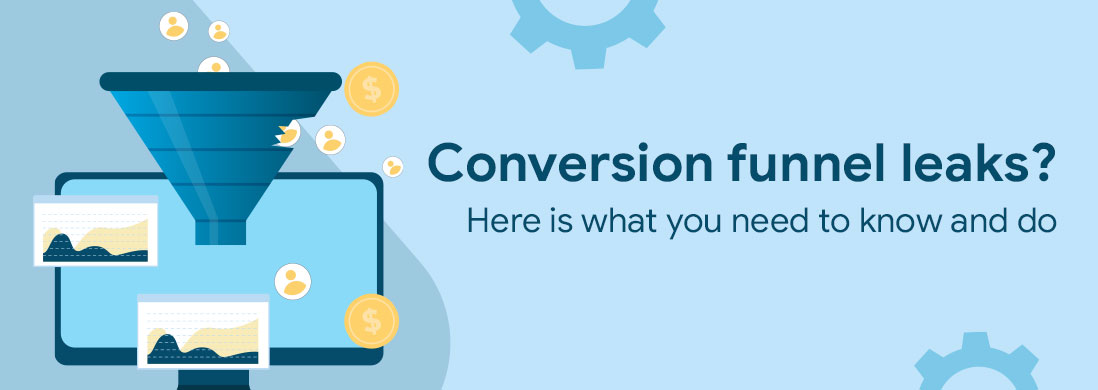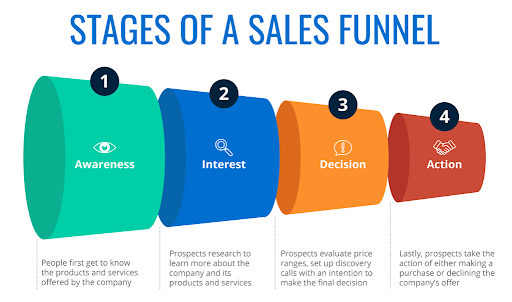A “conversion” refers to the specific action or goal that a business wants a customer to complete. It can vary depending on the business objectives and can include actions such as making a purchase, signing up for a newsletter, filling out a form, downloading an app, or subscribing to a service. Essentially, a conversion is when a potential customer successfully takes the desired action that aligns with the business’s goals. The conversion rate is often used as a metric to measure the effectiveness of marketing campaigns or the overall success of a website or landing page in achieving these desired actions.
What is Conversion Funnel?
A conversion funnel is a conceptual framework used in marketing and sales to describe the journey that a potential customer goes through before making a purchase or completing a desired action. It represents the process of converting a visitor into a customer.
The conversion funnel typically consists of several stages, each representing a step in the customer’s journey. While the specific stages may vary depending on the business and industry, here are the common stages of a conversion funnel:
- Awareness: In this stage, the awareness of your services, brand or product increases among potential customers.
- Interest: Once aware, potential customers develop an interest in your offering. They may engage further by visiting your website, reading content, watching videos, or subscribing to your newsletter.
- Desire: At this point, potential customers are ready to make a decision. They evaluate the value, pricing, and benefits of your offering compared to competitors. This stage often involves actions like adding items to a cart, initiating a trial, or requesting a quote.
- Action: The final stage is when the potential customer takes the desired action, such as making a purchase, signing up for a service, or subscribing to a membership. This action signifies the conversion from a prospect to a customer.
AWARENESS STAGE (How to TELL People?)
The awareness stage is the first stage in the conversion funnel, where potential customers become aware of a particular problem, need, or opportunity they have. In this stage, users start recognizing your brand even if they may not be familiar with your product.
Sometimes people drop off from the stage for various reasons. Some of them include:
- Lack of interest: People may not find your product or service relevant or compelling enough to explore further. They may not see the value it offers or perceive it as a solution to their needs.
- Poor targeting: If your marketing efforts are not reaching the right audience or are targeting individuals who are not interested in your offering, they are likely to lose interest and drop off.
- Ineffective messaging: If your messaging fails to communicate the unique benefits or value proposition of your product or service, potential customers may not see a reason to engage with your brand further.
To avoid drop-offs in the awareness stage and keep potential customers engaged, you can implement the following strategies:
- Targeted marketing: Ensure that your marketing efforts are well-targeted to reach the right audience who are more likely to be interested in your offering. Understand your potential customers and tailor your message and channels accordingly.
- Compelling content: Use engaging content.Provide information, insights, or solutions that addresses users pain points and interests, making them more likely to stay engaged and if possible, get their details to reachout later with offers or reminders.
- Personalization: Curate your messaging and content based on user preferences, demographics, etc. Personalization can make your brand feel more relevant and increase the likelihood of capturing and retaining their attention.
- Clear value proposition: Clearly communicate the unique benefits and value your product or service provides. Highlight how it solves problems or improves the lives of your potential customers, making them more interested in exploring further.
- Consistent brand presence: Maintain a consistent and cohesive brand presence across various channels. This helps build brand recognition, credibility, and trust, increasing the likelihood that potential customers will continue engaging with your brand.
- Retargeting: Implement retargeting strategies such as displaying relevant ads to people who have previously shown interest in your brand. This reminds them of your offering and can help re-engage potential customers who may have dropped off initially.
INTEREST STAGE (How to get others to CARE?)
The interest stage, also known as the consideration stage, is the second stage in the conversion funnel. At this stage, potential customers have moved beyond the awareness stage and have developed a genuine interest in your brand, product, or service. They are actively considering and evaluating your offering as a potential solution to their needs or desires
People may drop off from the interest stage for several reasons. Here are a few common factors:
- Lack of engaging content: If the content you provide during the interest stage is dull, uninformative, or fails to capture their attention, potential customers may lose interest and move on.
- Lengthy or complicated information: If the information you provide is overly long, complex, or difficult to understand, it can overwhelm potential customers and discourage them from exploring further.
- Lack of personalization: If you fail to personalize the content or communication during the interest stage, potential customers may not feel a strong connection to your brand and lose interest.
To keep potential customers engaged to avoid drop-off at this stage, you can use below strategies:
- Engaging and relevant content: Create encouraging and informative content that addresses their interests, needs, and pain points. You can present this information formats such as articles, videos, infographics, or interactive content to keep them engaged.
- Clear and concise information: Break it down into easily digestible chunks, use bullet points or visual aids to enhance understanding, and highlight the key benefits or features of your product or service.
- Personalization: Tailor your content and communication to individual preferences whenever possible. Leverage data and insights to deliver personalized recommendations, offers, or messages that resonate with the interests and needs of potential customers.
- Interactive experiences: Offer interactive experiences such as quizzes, assessments, or demos that allow potential customers to actively engage with your brand and gain a better understanding of your offering.
- Provide social proof: Incorporate customer testimonials, case studies, or reviews that showcase the positive experiences of existing customers. This can build trust and credibility, encouraging potential customers to remain interested in your brand.
- Prompt for further action: Encourage potential customers to take the next step in the customer journey by providing clear calls to action. This can include inviting them to sign up for a free trial, attend a webinar, or explore more in-depth resources.
DECISION STAGE (How to get them to WANT what you offer?)
The decision stage, also known as the evaluation stage or intent stage, is a stage in the conversion funnel where potential customers have moved beyond the initial interest and consideration phases. During this stage, they are actively evaluating and comparing different options to make a final decision before taking action
People may drop off from the decision stage for several reasons. Here are a few common factors:
- Lack of perceived value: If potential customers don’t see the value or benefits of your product or service, they may lose interest and drop off. They may not feel convinced that your offering can effectively address their needs or provide a solution.
- Concerns about price or affordability: If potential customers perceive your product or service as too expensive or if they have concerns about affordability, they may hesitate to move forward and drop off.
- Competitor comparisons: Potential customers might compare your offering with that of your competitors. If they find better options elsewhere or if they perceive stronger value propositions from competitors, they may abandon their desire to pursue your offering.
To avoid drop-offs at the desire stage and maintain the interest and intent of potential customers, consider the following strategies:
- Clear and compelling value proposition: Clearly communicate the unique value and benefits of your product or service. Highlight how it solves specific problems or fulfills desired outcomes for potential customers. Emphasize the unique features, advantages, or qualities that differentiate your offering from competitors.
- Address objections and concerns: Proactively address common objections and concerns potential customers may have. Provide transparent information about pricing, discounts, or payment options. Offer reassurances or guarantees to address any sort of doubts or fears they may have.
- Offer incentives or promotions: Providing incentives, discounts, or limited-time offers will create a sense of urgency in users mind and motivate them to take the desired action. This can help put aside any price-related concerns and encourage them to take desired action.
- Personalized nurturing: Create your communication and follow-up efforts to the needs and preferences of potential customers. You can send personalized emails, recommendations, or relevant content to keeps them engaged and nurture their desire for your offering.
- Streamline the purchase process: Keep the purchase process is simple, intuitive, and user-friendly. Minimize or remove any friction or obstacles that users may encounter in their journey. A smooth and seamless purchase experience can help prevent drop-offs.
ACTION STAGE (How to PULL the trigger? )
The action stage, also known as the conversion stage, is the final stage of the conversion funnel where potential customers take the desired action that aligns with the goals of the business. It is the culmination of their journey through the funnel, where they move from being a prospect to becoming a customer or taking the intended action.
Here are a few common reasons why people might abandon the action stage and some strategies to avoid it:
- Complexity or inconvenience: If the action process is overly complicated, time-consuming, or inconvenient, potential customers may abandon it. Simplify the process as much as possible, minimize the number of steps required, and ensure it is easy to navigate and complete.
- Technical issues or errors: Technical glitches, website errors, or payment processing issues can frustrate potential customers and lead to abandonment. Regularly test your website, payment systems, and any other tools involved in the action stage to ensure they are functioning properly.
- Lack of trust or security concerns: If customers have concerns about the security of their personal information, payment details, or the overall credibility of your business, they may hesitate to proceed with the action. Display trust indicators such as security badges, testimonials, and clear privacy policies to alleviate concerns and build trust.
- Unexpected costs or hidden charges: Surprising customers with additional costs, fees, or hidden charges during the action stage can cause frustration and lead to abandonment. Be transparent about pricing and clearly communicate any additional costs or fees upfront.
- Insufficient incentives or value proposition: If potential customers don’t perceive sufficient value or incentives to take the desired action, they may be less motivated to complete it. Clearly communicate the benefits, unique selling points, and any incentives or rewards associated with the action to enhance its perceived value.
- Lack of follow-up or confirmation: Failing to provide timely confirmation or follow-up communication after the action can leave customers uncertain about the success of their transaction or action. Send immediate confirmations, order details, or onboarding instructions to reassure customers and keep them engaged.
To avoid drop-offs at the action stage and improve conversion rates, consider implementing the following strategies:
- Streamline the process: Simplify and streamline the action process, making it as quick and easy as possible for customers to complete. Remove any unnecessary steps or form fields and provide clear instructions along the way.
- Optimize for mobile: Ensure that the action process is mobile-friendly and responsive. Many customers prefer to make purchases or take actions through their mobile devices, so a seamless mobile experience is crucial.
- Provide multiple payment options: Offer a variety of payment options to accommodate different customer preferences. This can include credit/debit cards, PayPal, digital wallets, or other popular payment methods.
- Display trust indicators: Establish trust by prominently displaying security badges, customer reviews, testimonials, and any relevant certifications that demonstrate the credibility and reliability of your business.
- Offer live chat or customer support: Provide accessible customer support during the action stage to assist customers with any questions or concerns they may have. Live chat, phone support, or responsive email support can help address issues in real-time.
- Continual testing and optimization: Regularly monitor and analyze the action process to identify any points of friction or drop-offs. Conduct A/B testing, user testing, and performance analysis to continually optimize the process and minimize obstacles.
In conclusion, experiencing conversion funnel drop-off can be a challenging hurdle to overcome, but armed with the right knowledge and strategies, you can turn the tide in your favor.




